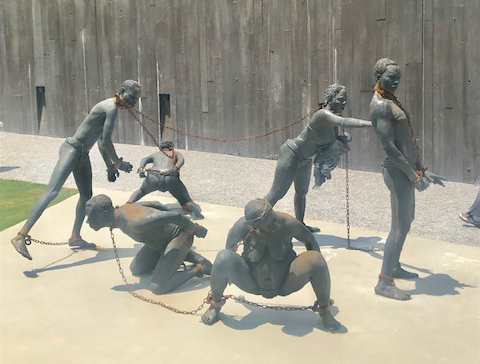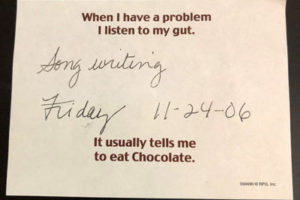Nkyinkyim by Kwame Akoto-Bamfo
We cannot hide our eyes from what really happened even though we would like to. This sculpture is a fair representation of history. It makes me want to vomit and cry. They sold slaves only a block or so from where the museum and memorial are located.
About the featured image of this blog
https://museumandmemorial.eji.org/news/2019-01-28/eji-releases-video-sculpture-about-enslavement
I grew up in the 1960s in the South . . . in Alabama. Being a child during that decade, I could not fully understand the political or racial issues playing out around me. I heard and saw snippets on the news about Gov. George Wallace, bus boycotts, freedom marches, and segregated lunch counters. Of course, the elementary school I attended was segregated. It wasn’t until my sixth-grade year in 1968-69 that schools in my town were desegregated. There was not a huge change at my school, only a few African American children switched schools that year.
The following year they redistricted the entire city which meant many students went to schools they were not expecting to attend. It did not change the school for me—however this greatly enlarged the number of students and combined kids who were from other areas of town besides my own. This change included more well-to-do families as well as black families.
And, let’s add some irony here. The junior high school where this happened was named for General Nathan Bedford Forrest who was a prominent Confederate Army general during the American Civil War. He was also the first Grand Wizard of the Ku Klux Klan. It was not until I was much older that I knew of his involvement with the KKK. And, I believe the school kept that name for decades. I just have to shake my head in disbelief. I don’t remember any problems in my school, although I am sure there may have been some. Friends in my circle seemed open to everyone. Yes, looking back I am sure I lived a life of white privilege—and still do.
Just Mercy
Several years ago, my husband and I watched the movie Just Mercy. All my friends told me this movie is a “must see.” The story is based on true events. Bryan Stevenson, a Harvard law graduate, comes to Alabama in 1989 to help defend poor people who can’t afford proper legal representation. He forms the Equal Justice Initiative in Montgomery, Alabama. His goal is to combat social injustices in criminal law and practice, which results in a high rate of African Americans convicted and incarcerated. He meets inmates who are on death row and who are seeking appeals. He ends up working to free a wrongly condemned death row prisoner.
The story is powerful and thought-provoking. The people depicted are real people. The events happened here in the state where I live. I watched in horror as the years that the events in the movie occurred flashed on the screen—the late 1980s into the 1990s. As the movie progressed, I was stunned that not much (if anything) had changed in twenty years. And, with the events of these past few years . . . many things have not changed in thirty or forty years.
It makes me want to scream that enough is enough. The deadly virus of racism and hatred infects the souls of those who harbor hate or pander to those systems or people who do. Ignoring polices that don’t affect us because we are white (or not in that group) keeps those systems alive. Change must come.
I have one life and one chance to make it count for something . . . My faith demands that I do whatever I can, wherever I am, whenever I can, for as long as I can with whatever I have to try to make a difference.
— Jimmy Carter (b. 1924) American retired politician who was the 39th president of the United States
The National Memorial for Peace and Justice
Bryan Stevenson, the lawyer portrayed in the movie Just Mercy, is founder and Executive Director of the EJI (Equal Justice Initiative) in Montgomery, Alabama. The EJI opened the Legacy Museum: From Enslavement to Mass Incarceration in Montgomery in 2018. The National Memorial for Peace and Justice is on a six-acre site nearby.
The National Memorial for Peace and Justice is a visual representation through sculpture, art, and design that contextualizes the lynching of black Americans. It includes a memorial square with eight hundred six-foot monuments to symbolize thousands of lynching victims and which list the counties and states where these took place. The names of the lynching victims are engraved on the columns.
This article from Smarthistory: The Center for Public Art History has pictures and describes the memorial in detail. The article also includes several interesting videos.
The National Memorial for Peace and Justice
Not long after the museum and memorial opened, I had the opportunity to visit. I urge everyone to go. Through interactive exhibits and videos, the Legacy Museum chronicles the enslavement of African Americans and the evolution of lynchings, segregation, and racial hierarchy in America.
Walking through the memorial is sobering and emotional. At the end of the memorial there is a large granite wall with water flowing down. After walking through the museum and memorial, I sat on a bench across from the wall. As I stared at the wall, I tried to take in all I had just seen. The emotions were overpowering. There are too many words, and yet, not enough words. The horror of slavery and lynching is unimaginable, yet it happened.
An African American woman was sitting there and we started a conversation. She had brought her family down from North Carolina to see the museum and memorial as they were on their way to visit family nearby.
The water flowing down reminded me of all the tears shed during these horrific events. It symbolized my tears over this horrendous, appalling part of our history. I commented to the lady about this. She responded that to her the water symbolized cleansing and healing. How beautiful, I thought. It is both . . . pain and sadness along with hope for cleansing and healing.
If she can express hope, perhaps I can, too . . . even with all that has happened in our country (and in my state, in my city). We can dream of a better future, a better world. I’ve come to realize that whatever you do to another human, you are doing to yourself, to your family, to your brother, to your sister.
Finally, I’ve come to believe that the true measure of our commitment to justice, the character of our society, our commitment to the rule of law, fairness, and equality cannot be measured by how we treat the rich, the powerful, the privileged, and the respected among us. The true measure of our character is how we treat the poor, the disfavored, the accused, the incarcerated, and the condemned.
― Bryan Stevenson (b. 1959) American lawyer, social justice activist, law professor, and founder and executive director of the Equal Justice Initiative
Sam Cooke wrote this song about his own experiences in the early 1960s. He released the song as a single in December 1964. He was also able to express hope.
“But I know a change is gonna come, oh yes it will”










Leave a Reply
Your email is safe with us.